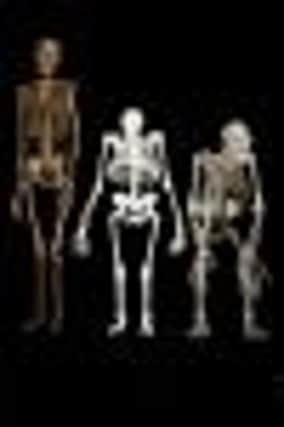Evidence of ‘missing link’ described by scientists


Several partial skeletons of the two million-year-old species Australopithecus sediba were discovered in South Africa in 2008.
After four years of work, an international team of scientists has now presented results from one of the most extensive studies of an extinct hominin, or human-like animal, ever conducted.
Advertisement
Hide AdAdvertisement
Hide AdSix research papers on the way the creature chewed and moved uncovered a complex mixture of traits. Some shared features seen in more evolved humans from the family Homo, while others were suggestive of more primitive apes.
Sediba had a small, chimp-like heel and appears to have walked in a unique way, with its feet slightly twisted inwards.
The odd gait may have been a compromise between upright walking and tree climbing, according to the authors, writing in the journal Science.
The creature also had ape-like upper limbs equipped for climbing and hanging from branches, but its hand and wrist were distinctly human.
A high shoulder joint would have given sediba an ape-like “shrugged” appearance, and its narrow upper rib cage was also reminiscent of large-bodied apes.
Yet the lower rib cage was more like that of a modern human, and while the creature had the same number of spinal vertebrae as people living today, its back was longer and more flexible. A study of sediba’s jaw and teeth, meanwhile, showed strong similarities with later human ancestors.
“All of the research so far shows that sediba had a mosaic of primitive traits and newer traits that suggest it was a bridge between earlier australopiths and the first humans,” said Professor Debbie Guatelli-Steinberg, one of the study authors from Ohio State University in the US.
Australopithecus sediba is in the same genus family as two other ancient hominins discovered in Africa, Australopithecus afarensis - the famous “Lucy” skeleton unearthed in Ethiopia in 1974 - and Australopithecus africanus, also from South Africa.
Both are up to a million years older than sediba.
The dental research indicates that both sediba and africanus are more closely related to modern humans than afarensis.